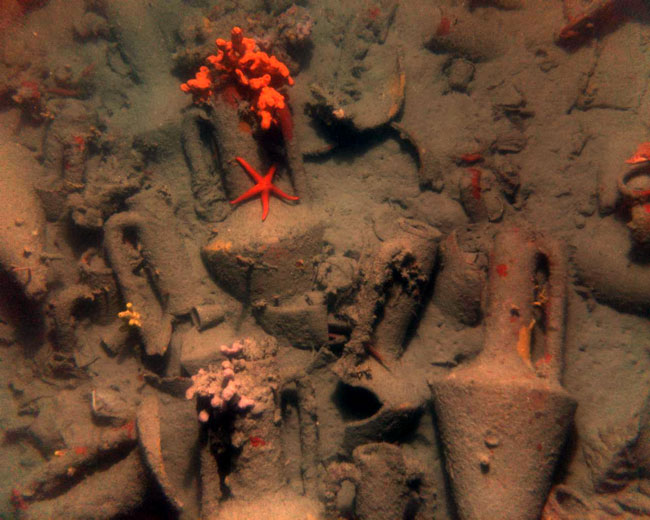Ingredients for Salad Dressing Found in 2,400-year-old Shipwreck

Genetic analysis has revealed the contents of an ancient shipwreck dating back to the era of the Roman Republic and Athenian Empire. The cargo was olive oil flavored with oregano.
Beyond discovering ingredients for Italian salad dressing on the sea floor, such research could provide a wealth of insights concerning the everyday life of ancient seafaring civilizations that would otherwise be lost at sea.
An international team of U.S. and Greek researchers investigated the remains of a 2,400-year-old shipwreck that lies 230 feet (70 meters) deep, roughly a half-mile (1 kilometer) off the coast of the Greek island of Chios in the Aegean Sea.
The shipwreck's contents, revealed in early 2006, has now been more fully analyzed. By deploying a robot to the wreck to collect two amphoras —two-handled earthenware jars often used by ancient Greeks and Romans—they were able to obtain DNA samples by scraping the insides of the ceramics.
Many archeologists specialize in the analysis of amphoras, which were used for shipping wine, oil, spices, grapes, olives, grain, nuts, fish and other commodities. Amphoras in a shipwreck can often reveal the age and nationality of the wreck, and at times they even hold their original contents, shedding light on ancient trade across the Mediterranean.
The study of amphoras can also be frustrating.
After centuries underwater, their contents have usually been washed away and researchers are "just left with empty bottles," said researcher Brendan Foley, a maritime archaeologist and historian of technology at the Woods Hole Oceanographic Institution in Massachusetts, who helped lead a 2005 expedition that explored and recovered two amphoras from the Chios wreck.
Sign up for the Live Science daily newsletter now
Get the world’s most fascinating discoveries delivered straight to your inbox.
Surprise
Foley and his colleagues identified the DNA contents of one amphora as olives and oregano, suggesting it held olive oil mixed with oregano, they announced recently. This came as a surprise, since Chios was well known as a major exporter of fine wines in antiquity, and archeologists had assumed that any cargo from that area would have been wine.
The other amphora the researchers analyzed may indeed have contained wine, although the DNA evidence they found there as yet remains uncertain.
"This is the first time that we've taken a jar like this that had no visible remains in it and known for sure what was in it," Foley told LiveScience.
The amphora that held the oregano-flavored oil was of a style distinct to Chios. That style made up roughly two-thirds of the more than 350 amphoras found on the wreck, suggesting the ship had sunk while outbound from the island, possibly due to strong fluke winds common near there.
"The fact that we detected DNA of olives may mean that Chios exported more than wine," Foley said. "Their agricultural production might have been more sophisticated than we've suspected."
The oregano may have done more than just flavor the oil.
"If you go up into the hills of Greece today, the older generation of women know that adding oregano, thyme or sage not just flavors the oil, but helps preserve it longer," Foley said. The ancient Greeks may have used herbs—and the antioxidants in them—to intentionally help preserve the oil, and possibly accidentally helped preserve the DNA the researchers sampled more than two millennia later.
Window to history
If the researchers' technique works on other containers, "we can begin to trace the agricultural production of different regions through time and their trading networks," Foley said. "We can see what crops were grown where and when, and this will give us an entirely new look at the ancient economy. We can see what they were growing, what they were eating and how they prepared and preserved foods." Such insights into ancient crops could even yield insights into the climate of that period.
The technique used to analyze ancient cargo DNA has its limits, the scientists stressed. For instance, it probably cannot reliably identify fish products, since any evidence of that could be contamination from the marine environment. It also remains to be seen whether this method can be used on amphoras stored in museums for years, whether it works on ceramics excavated from land sites, or whether it will only work on amphoras freshly salvaged from the ocean.
The scientists hope to go back and study a few dozen more amphoras from a variety of wrecks next year. Foley and his colleague Maria Hansson at Lund University in Sweden will detail their current findings in an upcoming issue of the Journal of Archeological Science.
- Quiz: The Artifact Wars
- Top 10 Ancient Capitals
- Top 10 Intrepid Explorers










